Sideloading or Manually installing APK files on your phone/tablet can help you get apps that are not available on the Google Play Store. The process is quite easy and could be finished with just a few taps. But there are a few things that you must do first. In this post, you will learn what an APK file is and how to manually install Android APK Files.
Advertisement
The instructions below can be followed for any Android smartphone or tablet running Android 10, Android 9 Pie, Android 8.1/8.0 Oreo, Android 7.1/7.0 Nougat, Android 6.0 Marshmallow, or below.
Page Contents
What is an APK?
Android Package Kit (abbreviated as “APK“) is the standard file format for mobile apps used in the Android operating system. An APK file to Android is what an executable EXE file is to the Windows OS. It is an installer file that you can open in Android to install applications.
When would you need to manually install an APK?
The Google Play Store is filled with millions of Android apps that offer a variety of features that make our lives easy. And it is surely the safest and most recommended way to get apps. But that doesn’t mean that it is the only place where you can download and install apps on your Android phone. There are certain apps that you may not find on the Play Store due to various reasons. Now in such instances, you may need to manually install the Android APK file of the said app(s).
Advertisement
A few of these instances when you’d need to manually install an APK have been listed below:
- Certain developers may choose not to publish their app on the Play Store at all. A good example of this is the infamous mobile game “Fortnite”. Or if you’re into Android rooting, then “Magisk Manager”.
- A specific app might have been pulled from the Play Store due to developer policy violation.
- The developer might have discontinued any further development of the app and voluntarily removed it.
- App developers may target a specific country and choose to restrict their apps based on geographical locations.
- Some apps may not even show up on the Google Play store if your Android phone’s bootloader is unlocked and it doesn’t pass the Play Protect certification. Netflix is one such app.
- The latest update of a specific app may have issues/bugs. And in this case, you may need to install the previous more stable version of the app manually.
- And then there are apps that may allow downloading of other apps (Alternate app stores) from within them. “Amazon App Store” and the open-source Android apps repository “F-Droid” are good examples of such apps.
So whatever your reason may be, you can download and manually install Android APK files pretty easily.
Now before you head below to the instructions; a word of caution.
Advertisement
Download Android APK Files
Warning: Not all apps available outside the Play Store are safe. Make sure that you do not download pirated apps, which may also contain malware. And also, stray away from online websites/resources that might distribute them.
Always download APK files from reputable sources (like the ones we have linked below) or those which are directly distributed by the app’s developer.
- APKMirror: If you’re looking for the latest version of an app that’s not available on the Google Play Store yet. Or, if you want to install a very specific version of an app.
- XDA-Labs: A complete hub for downloading apps for rooted Android devices.
- F-Droid: A huge repository of open-source Android apps.
Instructions to Install APK on Android
The process of manually installing APK files on Android is also commonly known as “Sideloading” and it’s quite easy. By default, Android prevents you from installing APK files from third-party unknown sources for the sake of integrity.
But if you’re absolutely sure of what you’re installing, then Android does offer a simple option with the settings menu, which when turned on allows the installation of APK files. Once this option is turned on, you can download the APK file of your desired app and use the in-built Package Installer to manually install the Android APK file on your phone.
Now we have covered the complete process in the instructions below.
Advertisement
Step 1: Allow Installation of APK Files
The first step is to enable ‘Install unknown apps’ on your Android phone running Android Oreo and above, or ‘Unknown Sources’ if your phone is running Android Nougat and below. We have split the instructions into two sub-steps depending on the Android version installed on the phone.
Step 1.1: Enable ‘Unknown Sources’ on Android Nougat and Below
- Go to the ‘Settings’ menu on your Android phone.
- Scroll down and select ‘Security’.
- Find the ‘Unkown sources’ option by scrolling down the screen.
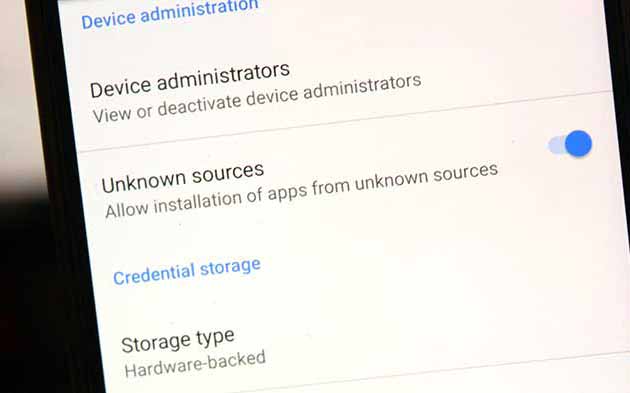
- Simply turn on the toggle next to ‘Unknown sources’ to allow the installation of unknown apps.
Step 1.2: Enable ‘Install unknown apps’ on Android 10, Android Pie, and Android Oreo
With Android Oreo, Google replaced the ‘Unknown sources’ option and introduced a more granular model of controlling which sources are allowed to install apps from unknown sources. The new option can be enabled as follows:
- Go to ‘Settings’ on your Android phone.
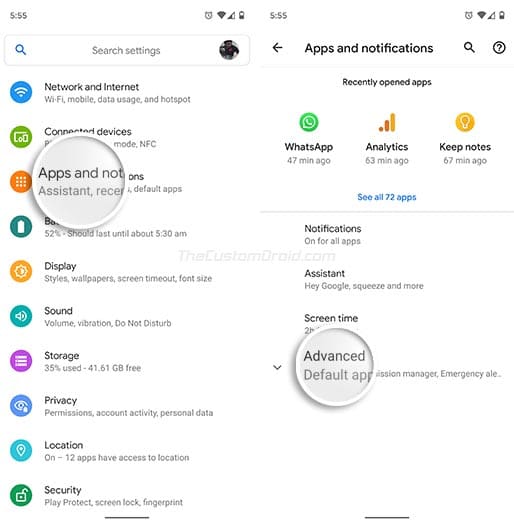
- Tap on ‘Apps and notifications’.
- Tap on ‘Advanced’ to expand the menu and select ‘Special app access’.
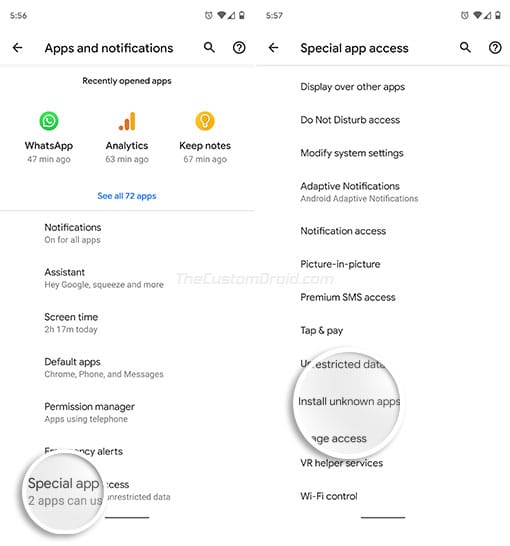
- Choose ‘Install unknown apps’.
- You will see the list of apps that have the ability to download and install applications.
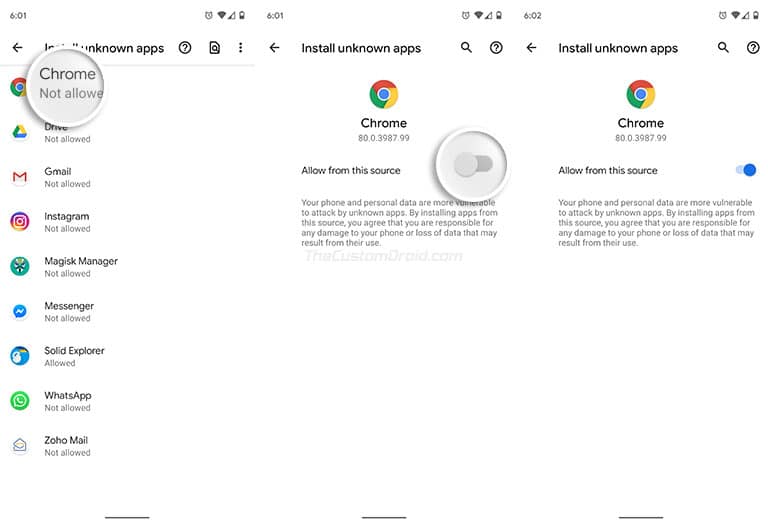
- As an example, if you’re going to download and install unknown apps using Chrome, then select ‘Chrome’ and turn ON the toggle next to ‘Allow from this source’.
With the option enabled, your phone is now ready are now ready to install Android APK files.
Step 2: Manually Install APK on Android
- First, download the APK file of the app you want to install.
- If you have downloaded it to the PC, then connect the phone to the PC using the USB cable.
- Enable MTP/File Transfer mode on your Android phone.
- Transfer the downloaded APK file to the root (not inside any folder) of your phone’s internal storage, so that it’s easy to find it later.
- Now, download a file manager app from the Play Store of your choice and install it.
- If your phone already has a preinstalled file manager app, then there’s no need to do this.
- Go to the app drawer and launch the file manager app (e.g. Solid Explorer).
- Navigate to the phone’s internal storage and find the Android APK file you transferred earlier.
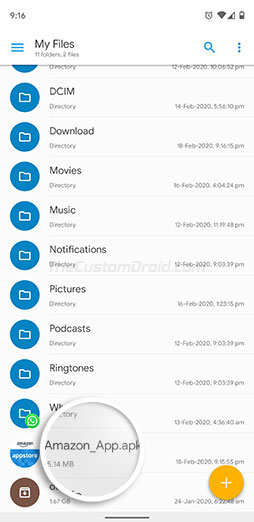
- Now, tap on the APK file to initiate the installation using Android’s built-in package installer.
- A prompt will be shown on the phone’s screen to confirm whether you really want to install the app or not.
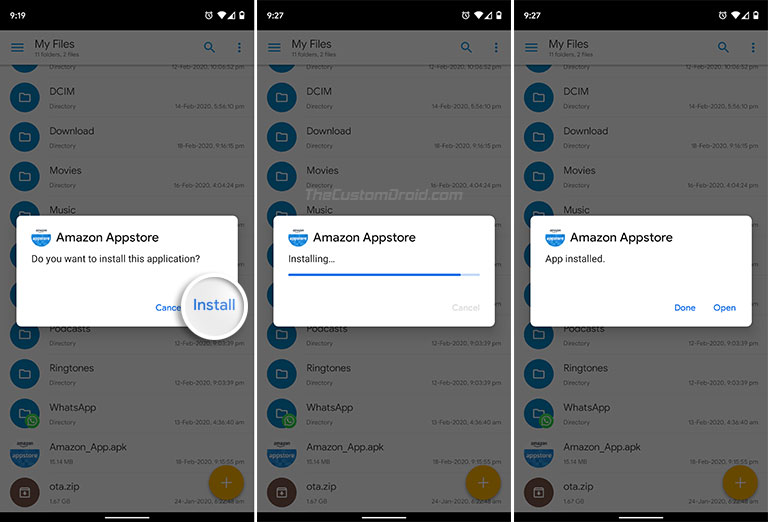
Note: The package installer UI may vary depending on the Android version installed. - Finally, press the ‘Install’ button to confirm and install the APK file on your Android phone.
The installation could take a few seconds to finish. Once it is, the app should be installed. You can now launch it from the app drawer of your phone.
Advertisement
Now before you leave, know that Google Play Store is still the quickest and safest way to install apps on your Android device. It’s Play Protect protection mechanism makes sure that all apps are free from malware even before you install them. So, you should only resort to manual installation if and when necessary. And it would also be a good idea to disable the installation of apps from unknown sources to further prevent any malicious installations.
Enable USB Debugging on Any Android Device
Transfer Files Between PC and Android Devices using ADB Commands
How to Manually Install OTA Updates on Android
[/color]
So, this was our guide to sideload/manually install Android APK files. We hope you found it to be helpful. This post is also a part of the Android 101 series where we cover the basics of using and operating Android devices. If you have any questions regarding the APK files or their installation, feel free to let us know through the comments.